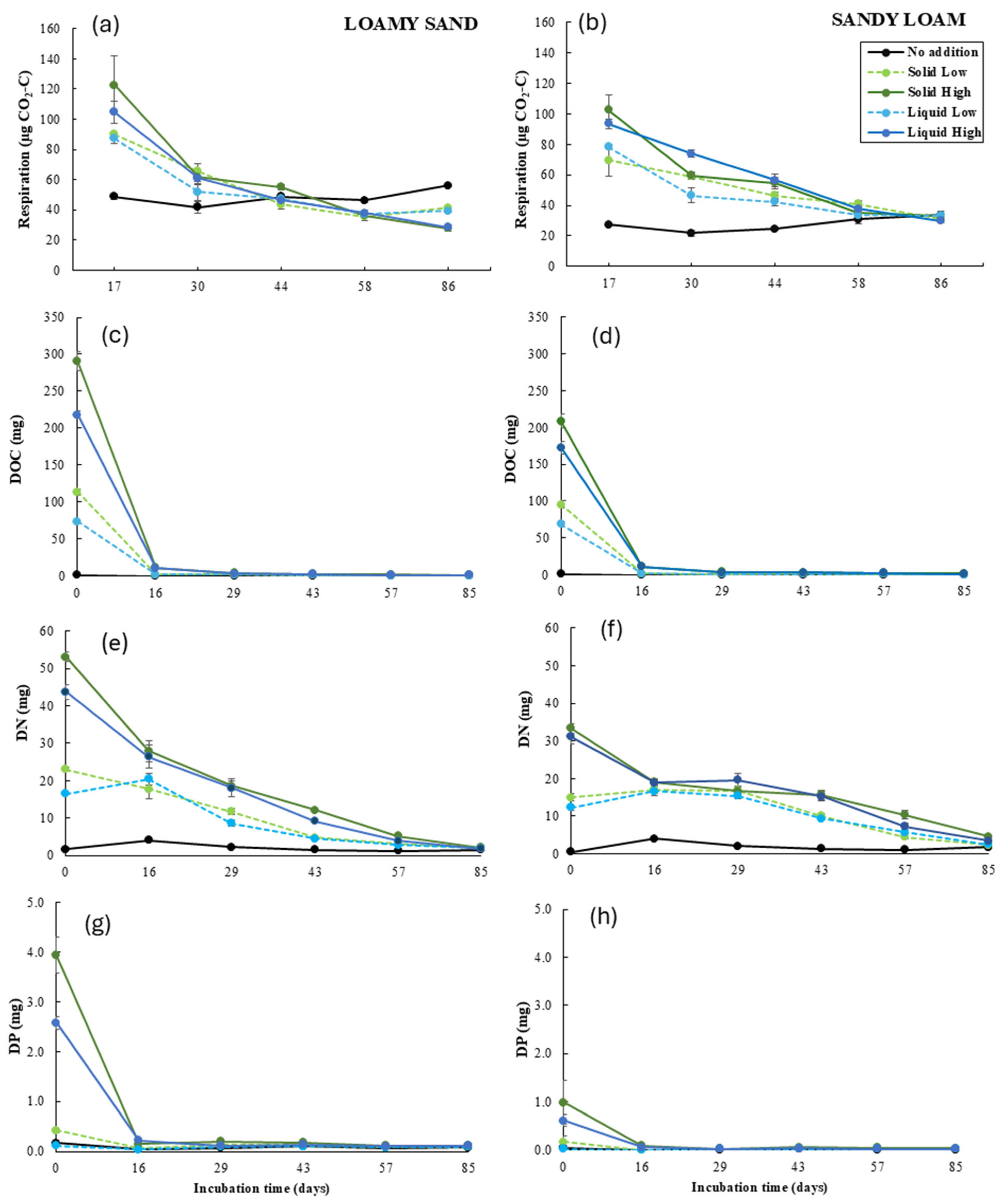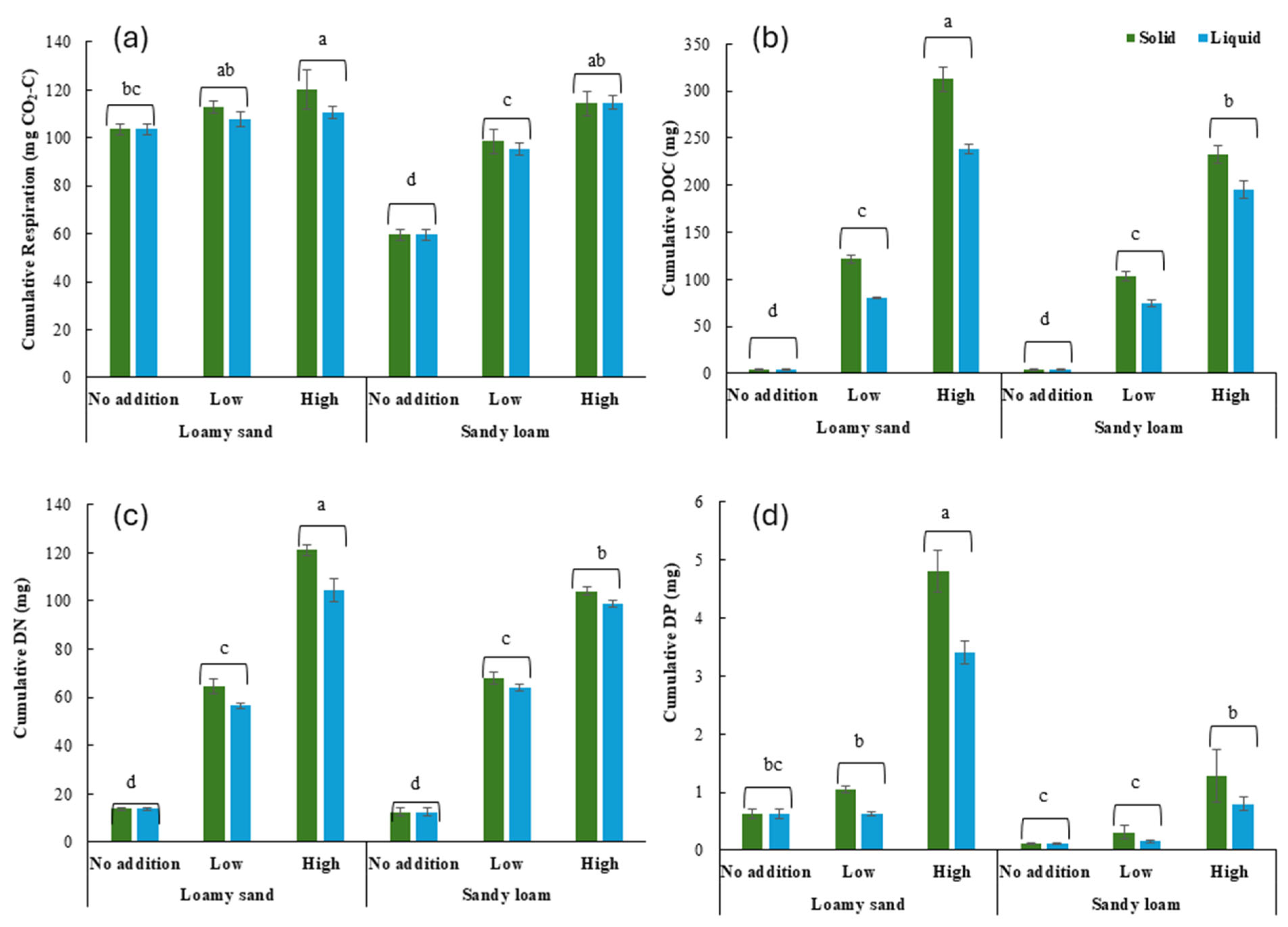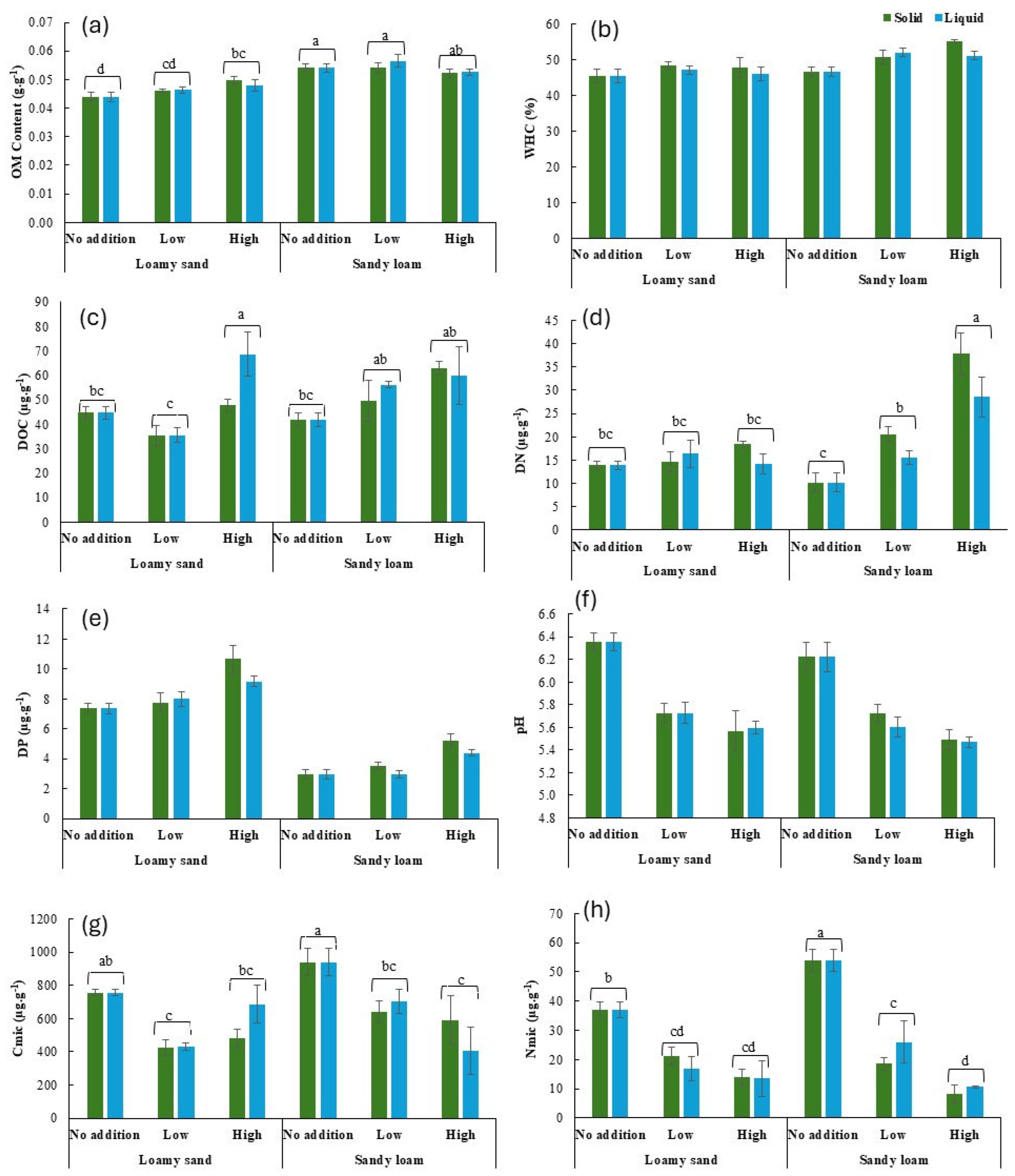Laboratory Optimization of Poultry Feather Hydrolysate Application for Soil Fertility: Effects of Soil Texture and Hydrolysate State and Addition Rate
Abstract
1. Introduction
2. Materials and Methods
2.1. Collection and Preparation of Soils and Hydrolysate
2.2. Microcosm Experiment
2.3. Soil Analyses
2.4. Statistical Analysis
3. Results
3.1. Soil Respiration and Nutrient Content in the Leachates During Incubation
3.2. Cumulative Soil Respiration and Nutrient Content in the Leachates
3.3. Soil Properties
4. Discussion
5. Conclusions
Author Contributions
Funding
Data Availability Statement
Acknowledgments
Conflicts of Interest
References
- Tripathi, S.; Srivastava, P.; Devi, R.S.; Bhadouria, R. Influence of synthetic fertilizers and pesticides on soil health and soil microbiology. In Agrochemicals Detection, Treatment and Remediation; Butterworth-Heinemann: Woburn, MA, USA, 2020; pp. 25–54. [Google Scholar] [CrossRef]
- Gerke, J. The central role of soil organic matter in soil fertility and carbon storage. Soil Syst. 2022, 6, 33. [Google Scholar] [CrossRef]
- Lal, R. Soil organic matter and water retention. Agron. J. 2020, 112, 3265–3277. [Google Scholar] [CrossRef]
- Li, H.; Van den Bulcke, J.; Mendoza, O.; Deroo, H.; Haesaert, G.; Dewitte, K.; De Neve, S.; Sleutel, S. Soil texture controls added organic matter mineralization by regulating soil moisture—Evidence from a field experiment in a maritime climate. Geoderma 2022, 410, 115690. [Google Scholar] [CrossRef]
- Martín-Lammerding, D.; Gabriel, J.L.; Zambrana, E.; Santín-Montanyá, I.; Tenorio, J.L. Organic amendment vs. Mineral fertilization under minimum tillage: Changes in soil nutrients, soil organic matter, biological properties and yield after 10 years. Agriculture 2021, 11, 700. [Google Scholar] [CrossRef]
- Bhari, R.; Kaur, M.; Sarup Singh, R. Chicken feather waste hydrolysate as a superior biofertilizer in agroindustry. Curr. Microbiol. 2021, 78, 2212–2230. [Google Scholar] [CrossRef] [PubMed]
- Kaur, M.; Bhari, R.; Singh, R.S. Chicken feather waste-derived protein hydrolysate as a potential biostimulant for cultivation of mung beans. Biologia 2021, 76, 1807–1815. [Google Scholar] [CrossRef]
- Sobucki, L.; Ramos, R.F.; Gubiani, E.; Brunetto, G.; Kaiser, D.R.; Daroit, D.J. Feather hydrolysate as a promising nitrogen-rich fertilizer for greenhouse lettuce cultivation. Int. J. Recycl. Org. Waste Agric. 2019, 8, 493–499. [Google Scholar] [CrossRef]
- Liya, S.M.; Umesh, M. Bioconversion of chicken feather waste into feather hydrolysate by multifaceted keratinolytic Bacillus tropicus LS27 and new insights into its antioxidant and plant growth-promoting properties. Biomass Convers. Biorefin. 2023, 1–11. [Google Scholar] [CrossRef]
- Šolcová, O.; Knapek, J.; Wimmerová, L.; Vavrová, K.; Králík, T.; Rousková, M.; Šabata, S.; Hanika, J. Environmental aspects and economic evaluation of new green hydrolysis method for waste feather processing. Clean Technol. Environ. Policy 2021, 23, 1863–1872. [Google Scholar] [CrossRef]
- Raguraj, S.; Kasim, S.; Md Jaafar, N.; Nazli, M.H. Growth of tea nursery plants as influenced by different rates of protein hydrolysate derived from chicken feathers. Agronomy 2022, 12, 299. [Google Scholar] [CrossRef]
- Rouphael, Y.; Carillo, P.; Cristofano, F.; Cardarelli, M.; Colla, G. Effects of vegetal-versus animal-derived protein hydrolysate on sweet basil morpho-physiological and metabolic traits. Sci. Hortic. 2021, 284, 110123. [Google Scholar] [CrossRef]
- Adelere, I.A.; Lateef, A. Application of bacterial feather hydrolysates as biofertilizers in growing leafy vegetables: Yield, nutritional, phytochemical, antioxidant and hepatoprotective profiles. Clean Technol. Environ. Policy 2023, 25, 2951–2969. [Google Scholar] [CrossRef]
- Gupta, S.; Sharma, S.; Aich, A.; Verma, A.K.; Bhuyar, P.; Nadda, A.K.; Mulla, S.; Kalia, S. Chicken feather waste hydrolysate as a potential biofertilizer for environmental sustainability in organic agriculture management. Waste Biomass Valorization 2023, 14, 2783–2799. [Google Scholar] [CrossRef]
- Colla, G.; Hoagland, L.; Ruzzi, M.; Cardarelli, M.; Bonini, P.; Canaguier, R.; Rouphael, Y. Biostimulant action of protein hydrolysates: Unraveling their effects on plant physiology and microbiome. Front. Plant Sci. 2017, 8, 2202. [Google Scholar] [CrossRef]
- Rouphael, Y.; Colla, G.; Giordano, M.; El-Nakhel, C.; Kyriacou, M.C.; De Pascale, S. Foliar applications of a legume-derived protein hydrolysate elicit dose-dependent increases of growth, leaf mineral composition, yield and fruit quality in two greenhouse tomato cultivars. Sci. Hortic. 2017, 226, 353–360. [Google Scholar] [CrossRef]
- Możejko, M.; Bohacz, J. Effect of keratin hydrolysates obtained from feather decomposition by Trichophyton ajelloi on plant germination, growth and biological activity of selected arable soils under model conditions. Agronomy 2023, 13, 187. [Google Scholar] [CrossRef]
- Raguraj, S.; Kasim, S.; Jaafar, N.M.; Nazli, M.H. Influence of chicken feather waste derived protein hydrolysate on the growth of tea plants under different application methods and fertilizer rates. Environ. Sci. Pollut. Res. 2023, 30, 37017–37028. [Google Scholar] [CrossRef]
- Tamreihao, K.; Mukherjee, S.; Khunjamayum, R.; Devi, L.J.; Asem, R.S.; Ningthoujam, D.S. Feather degradation by keratinolytic bacteria and biofertilizing potential for sustainable agricultural production. J. Basic Microbiol. 2019, 59, 4–13. [Google Scholar] [CrossRef]
- Dume, B.; Hanc, A.; Švehla, P.; Michal, P.; Šolcová, O.; Chane, A.D.; Nigussie, A. Nutrient recovery and changes in enzyme activity during vermicomposting of hydrolysed chicken feather residue. Environ. Technol. 2022, 1–15. [Google Scholar] [CrossRef]
- Jagadeesan, Y.; Meenakshisundaram, S.; Raja, K.; Balaiah, A. Sustainable and efficient-recycling approach of chicken feather waste into liquid protein hydrolysate with biostimulant efficacy on plant, soil fertility and soil microbial consortium: A perspective to promote the circular economy. Process Saf. Environ. Prot. 2023, 170, 573–583. [Google Scholar] [CrossRef]
- Kellerová, A.; Jílková, V. Short-term effects of microbial exopolysaccharides and chicken feather hydrolysate vs. long-term effects of plant-derived biochar on temperate, coarse-textured agricultural soils. Soil Use Manag. 2025, 41, e70029. [Google Scholar] [CrossRef]
- Bondì, C.; Castellini, M.; Iovino, M. Temporal variability of physical quality of a sandy loam soil amended with compost. Biologia 2025, 80, 1221–1232. [Google Scholar] [CrossRef]
- Chwil, S.; Matraszek, R.; Kozłowska-Strawska, J.; Chwil, M.; Zapalski, P. Effects of protein hydrolysate on soil fertility and heavy-metal accumulation in Sinapis alba L. Commun. Soil Sci. Plant Anal. 2016, 47, 298–304. [Google Scholar] [CrossRef]
- Murphy, J.A.M.E.S.; Riley, J.P. A modified single solution method for the determination of phosphate in natural waters. Anal. Chim. Acta 1962, 27, 31–36. [Google Scholar] [CrossRef]
- Vance, E.D.; Brookes, P.C.; Jenkinson, D.S. An extraction method for measuring soil microbial biomass C. Soil Biol. Biochem. 1987, 19, 703–707. [Google Scholar] [CrossRef]
- Gee, G.W.; Bauder, J.W. Particle-size analysis. In Methods of Soil Analysis: Part 1 Physical and Mineralogical Methods; American Society of Agronomy, Inc.: Madison, WI, USA, 1986; pp. 383–411. [Google Scholar] [CrossRef]
- Jílková, V.; Jandová, K.; Sim, A.; Thornton, B.; Paterson, E. Soil organic matter decomposition and carbon sequestration in temperate coniferous forest soils affected by soluble and insoluble spruce needle fractions. Soil Biol. Biochem. 2019, 138, 107595. [Google Scholar] [CrossRef]
- Major, J.; Rondon, M.; Molina, D.; Riha, S.J.; Lehmann, J. Maize yield and nutrition during 4 years after biochar application to a Colombian savanna oxisol. Plant Soil 2010, 333, 117–128. [Google Scholar] [CrossRef]
- Jain, R.; Jain, A.; Rawat, N.; Nair, M.; Gumashta, R. Feather hydrolysate from Streptomyces sampsonii GS 1322: A potential low cost soil amendment. J. Biosci. Bioeng. 2016, 121, 672–677. [Google Scholar] [CrossRef]
- Kellerová, A.; Angst, G.; Jílková, V. Earthworms facilitate stabilization of both more-available maize biomass and more-recalcitrant maize biochar on mineral particles in an agricultural soil. Soil Biol. Biochem. 2024, 189, 109278. [Google Scholar] [CrossRef]
- Goda, D.A.; El-Gamal, E.H.; Rashad, M.; Abdel-Fattah, Y.R. The optimization of calcareous soil cation exchange capacity via the feather hydrolysate and NP fertilizers integration. Sci. Rep. 2025, 15, 4676. [Google Scholar] [CrossRef]
- Mitsuta, A.; Lourenço, K.S.; de Oliveira, B.G.; de Assis Costa, O.Y.; Cantarella, H.; Kuramae, E.E. Soil pH determines the shift of key microbial energy metabolic pathways associated with soil nutrient cycle. Appl. Soil Ecol. 2025, 208, 105992. [Google Scholar] [CrossRef]
- Tahir, S.; Marschner, P. Clay addition to sandy soil reduces nutrient leaching—Effect of clay concentration and ped size. Commun. Soil Sci. Plant Anal. 2017, 48, 1813–1821. [Google Scholar] [CrossRef]
- Łyszczarz, S.; Lasota, J.; Szuszkiewicz, M.M.; Błońska, E. Soil texture as a key driver of polycyclic aromatic hydrocarbons (PAHs) distribution in forest topsoils. Sci. Rep. 2021, 11, 14708. [Google Scholar] [CrossRef] [PubMed]
- Zhou, J.; Sun, T.; Shi, L.; Kurganova, I.; de Gerenyu, V.L.; Kalinina, O.; Giani, L.; Kuzyakov, Y. Organic carbon accumulation and microbial activities in arable soils after abandonment: A chronosequence study. Geoderma 2023, 435, 116496. [Google Scholar] [CrossRef]
- Plante, A.F.; Conant, R.T.; Stewart, C.E.; Paustian, K.; Six, J. Impact of soil texture on the distribution of soil organic matter in physical and chemical fractions. Soil Sci. Soc. Am. J. 2006, 70, 287–296. [Google Scholar] [CrossRef]
- Witzgall, K.; Vidal, A.; Schubert, D.I.; Höschen, C.; Schweizer, S.A.; Buegger, F.; Pouteau, V.; Chenu, C.; Mueller, C.W. Particulate organic matter as a functional soil component for persistent soil organic carbon. Nat. Commun. 2021, 12, 4115. [Google Scholar] [CrossRef]
- Wang, X.; Song, L. Advances in the Study of NO3− Immobilization by Microbes in Agricultural Soils. Nitrogen 2024, 5, 927–940. [Google Scholar] [CrossRef]
- Kalbitz, K.; Solinger, S.; Park, J.H.; Michalzik, B.; Matzner, E. Controls on the dynamics of dissolved organic matter in soils: A review. Soil Sci. 2000, 165, 277–304. [Google Scholar] [CrossRef]
- Nurdiawati, A.; Suherman, C.; Maxiselly, Y.; Akbar, M.A.; Purwoko, B.A.; Prawisudha, P.; Yoshikawa, K. Liquid feather protein hydrolysate as a potential fertilizer to increase growth and yield of patchouli (Pogostemon cablin Benth) and mung bean (Vigna radiata). Int. J. Recycl. Org. Waste Agric. 2019, 8, 221–232. [Google Scholar] [CrossRef]




| Soil/ Hydrolysate | OM (g g−1) | WHC (%) | TOC (mg g−1) | TN (mg g−1) | TP (mg g−1) | DOC (mg g−1) | DN (mg g−1) | DP (mg g−1) | pH | Cmic (µg g−1) | Nmic (µg g−1) |
|---|---|---|---|---|---|---|---|---|---|---|---|
| Loamy sand | 0.042 ± 0.001 b | 54.88 ± 3.35 a | 17.53 ± 0.28 a | 1.68 ± 0.05 a | 0.74 ± 0.03 a | 0.033 ± 0.007 a | 0.025 ± 0.001 a | 0.004 ± 0.000 a | 6.57 ± 0.07 a | 680.92 ± 43.61 a | 43.93 ± 0.174 a |
| Sandy loam | 0.047 ± 0.000 a | 52.13 ± 8.19 a | 17.01 ± 0.34 a | 1.77 ± 0.03 a | 0.88 ± 0.04 a | 0.030 ± 0.002 a | 0.014 ± 0.001 b | 0.002 ± 0.000 b | 6.60 ± 0.09 a | 587.95 ± 58.25 a | 38.28 ± 1.85 b |
| Hydrolysate | 0.879 ± 0.001 | – | 384.54 ± 0.54 | 109.81 ± 0.19 | 12.43 ± 0.28 | 310.34 ± 5.18 | 100.10 ± 1.55 | 5.67 ± 0.095 | 4.07 ± 0.01 | – | – |
| Source of Variance | df | Cumulative Respiration | Cumulative DOC | Cumulative DN | Cumulative DP |
|---|---|---|---|---|---|
| S | 1, 36 | 76.93 *** | 48.65 *** | 3.56 NS | 165.53 *** |
| ST | 1, 36 | 1.72 NS | 74.11 *** | 19.89 *** | 14.45 *** |
| AR | 2, 36 | 78.13 *** | 1583.9 *** | 1915.6 *** | 171.42 *** |
| S × ST | 1, 36 | 0.84 NS | 5.37 * | 4.43 * | 3.33 NS |
| S × AR | 2, 36 | 33.66 *** | 28.39 *** | 15.36 *** | 59.75 *** |
| ST × AR | 2, 36 | 0.43 NS | 21.56 *** | 6.26 * | 6.70 ** |
| S × ST × AR | 2, 36 | 0.44 NS | 2.27 NS | 1.82 NS | 1.58 NS |
| Source of Variance | df | OM | WHC | DOC | DN | DP | pH | Cmic | Nmic |
|---|---|---|---|---|---|---|---|---|---|
| S | 1, 36 | 75.97 *** | 15.71 *** | 3.48 NS | 13.59 *** | 338.4 *** | 2.84 NS | 5.77 * | 5.56 * |
| ST | 1, 36 | 0.04 NS | 1.04 NS | 1.69 NS | 3.81 NS | 2.9 NS | 0.10 NS | 0.09 NS | 0.15 NS |
| AR | 2, 36 | 1.76 NS | 7.16 ** | 11.49 *** | 27.00 *** | 27.9 *** | 60.92 *** | 17.70 *** | 81.75 *** |
| S × ST | 1, 36 | 0.67 NS | 0.05 NS | 0.90 NS | 1.91 NS | 0.0 NS | 0.23 NS | 1.33 NS | 1.18 NS |
| S × AR | 2, 36 | 5.28 ** | 2.30 NS | 3.67 * | 18.22 *** | 0.7 NS | 0.10 NS | 4.37 * | 7.72 ** |
| ST × AR | 2, 36 | 0.50 NS | 1.06 NS | 0.67 NS | 2.03 NS | 2.0 NS | 0.11 NS | 0.05 NS | 0.05 NS |
| S × ST × AR | 2, 36 | 0.17 NS | 0.62 NS | 2.13 NS | 0.51 NS | 0.7 NS | 0.09 NS | 2.12 NS | 0.60 NS |
Disclaimer/Publisher’s Note: The statements, opinions and data contained in all publications are solely those of the individual author(s) and contributor(s) and not of MDPI and/or the editor(s). MDPI and/or the editor(s) disclaim responsibility for any injury to people or property resulting from any ideas, methods, instructions or products referred to in the content. |
© 2025 by the authors. Licensee MDPI, Basel, Switzerland. This article is an open access article distributed under the terms and conditions of the Creative Commons Attribution (CC BY) license (https://creativecommons.org/licenses/by/4.0/).
Share and Cite
Roy, A.; Jílková, V. Laboratory Optimization of Poultry Feather Hydrolysate Application for Soil Fertility: Effects of Soil Texture and Hydrolysate State and Addition Rate. Agronomy 2025, 15, 1638. https://doi.org/10.3390/agronomy15071638
Roy A, Jílková V. Laboratory Optimization of Poultry Feather Hydrolysate Application for Soil Fertility: Effects of Soil Texture and Hydrolysate State and Addition Rate. Agronomy. 2025; 15(7):1638. https://doi.org/10.3390/agronomy15071638
Chicago/Turabian StyleRoy, Aditi, and Veronika Jílková. 2025. "Laboratory Optimization of Poultry Feather Hydrolysate Application for Soil Fertility: Effects of Soil Texture and Hydrolysate State and Addition Rate" Agronomy 15, no. 7: 1638. https://doi.org/10.3390/agronomy15071638
APA StyleRoy, A., & Jílková, V. (2025). Laboratory Optimization of Poultry Feather Hydrolysate Application for Soil Fertility: Effects of Soil Texture and Hydrolysate State and Addition Rate. Agronomy, 15(7), 1638. https://doi.org/10.3390/agronomy15071638





